 W
WZwicken is an old Austrian and German card game for 4 to 6 players, which is usually played for small stakes and makes a good party game. It is one of the Rams group of card games characterised by allowing players to drop out of the current game if they think they will be unable to win any tricks or a minimum number of tricks.
 W
WBauernfangen is an old, trick-taking card game for 4 – 5 players, that used to be very popular especially in the Upper Austrian Hausruckviertel. Today it is also played in Lower Austria.
 W
WThe card game of Bauernschnapsen is an expanded form of the popular Austrian card game of Schnapsen, played by four players. This variant of Schnapsen is played throughout the whole of Austria.
 W
WBauerntarock also called Brixentaler Bauerntarock, is a point-trick card game played in the Brixental, Austria. It may have originated in the 19th century as an adaptation of the 54-card Tapp Tarock game onto the cheaper and smaller 36-card German deck. Another possibility is that it was adapted from the 78-card Taroc l'Hombre game as the ratio of trumps to non-trumps is almost the same. It uses the Skat Schedule found in popular regional games such as Jass and Schafkopf. It is closely related to Bavarian Tarock, Württemberg Tarock, and especially Dobbm. Like Bavarian Tarock and Tapp, Brixental Bauerntarock and Dobbm do not belong to the true tarot games, but have adopted rules from Tapp Tarock. The most fundamental difference between these games and true tarot games is in the use of German or French decks instead of true Tarot playing cards.
 W
WBieten, Laubbieten, Lab bietn or Labbieten or Bavarian Poker is a card game that is popular in the Austrian Tyrol and the Bavarian Prealps. It used to be a game frequently played by timber rafters and muleteers. It can be seen as a precursor to the traditional Tyrolean game of Perlaggen. The unusual feature of Bieten is the nature of the competition. The players have the option, even if they have a poor hand, of persuading their opponent(s) to cave in through skilful bidding (Bieten) and bluffing.
 W
WDobbm or Tappen is a card game played in the Stubaital valley in Austria which, like Brixental Bauerntarock, Bavarian Tarock and Württemberg Tarock, is not a true Tarock game, but is one of a family of games derived from Tapp Tarock by adapting its rules to a regular, shortened pack of 36 cards. The ranking and point value of the cards in Dobbm is identical with those of the other variants mentioned. In Dobbm as well, one player always plays as a soloist against all the others. It most strongly resembles the Brixental variant: Dobbm is also played by four players, each player is dealt eight cards, four cards go to the talon and Hearts are the permanent trump suit. The fundamental difference between games of the Tapp family and true tarot games is in the use of shortened German or French packs instead of true Tarot playing cards.
 W
WDreiertarock is a 3-handed card game of the Austrian Tarock family. Although less popular than it once was, it is still played in Austria, especially in Carinthia, and, in 2013, it was one of five variants of Tarock game competed for in the International Piatnik Tarock Tournament in Vienna. For a long time, three-handed variants of Tarock were played alongside the four-handed games and were very popular everywhere in Austria. They have since fallen behind in popularity which "is a pity because they are interesting variants which demand a high level of skill".
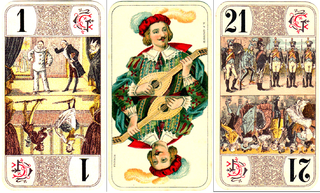 W
WDroggn, sometimes called French Tarock is an extinct card game from the Austrian branch of the Tarock family for three players that was played in the Stubai valley in Tyrol, Austria until the 1980s. Droggn is originally local dialect for "to play Tarock", but it has become the proper name of this specific Tarock variant. An unusual feature of the game compared with other Tarock games is the use of a 66-card deck and that there is no record in the literature of a 66-card game and no current manufacturers of a such a deck. The structure of the game strongly indicates that it is descended from the later version of Tarok l'Hombre, a 78-card Tarock game popular in 19th-century Austria and Germany, but with the subsequent addition of two higher bids.
 W
WGrasobern, Grasoberl, Grasoberln, Graseberla, Grünobern, Lauboberl or Laubobern is a card game that was once commonly played in Old Bavaria, especially in the old counties of Bad Aibling and Rosenheim, and is still popular in eastern Bavaria, especially in Upper Palatinate. The game has relatively simple rules and thus a rather relaxing and leisurely character without the mental demands of Schafkopf or psychological stress of Watten.
 W
WZwicken is an old Austrian and German card game for 4 to 6 players, which is usually played for small stakes and makes a good party game. It is one of the Rams group of card games characterised by allowing players to drop out of the current game if they think they will be unable to win any tricks or a minimum number of tricks.
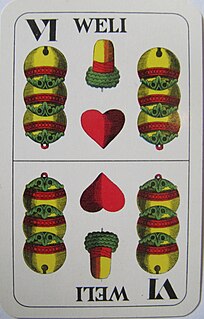 W
WMulatschak or Fuchzenawa is an Austrian card game for two to five players that comes from the Salzburg area and is considered the quintessential game of the region. Although Mulatschak has been called the national card game of Salzburg, its rules were almost certainly unpublished before 2004. Mulatschak is a member of the Rams family in which the key feature is that players may choose to drop out of the game if they believe their hand is not strong enough to take a minimum number of tricks. There is a variant known as Murln or Murlen, which is played in Vienna and the Styria.
 W
WGrasobern, Grasoberl, Grasoberln, Graseberla, Grünobern, Lauboberl or Laubobern is a card game that was once commonly played in Old Bavaria, especially in the old counties of Bad Aibling and Rosenheim, and is still popular in eastern Bavaria, especially in Upper Palatinate. The game has relatively simple rules and thus a rather relaxing and leisurely character without the mental demands of Schafkopf or psychological stress of Watten.
 W
WGrasobern, Grasoberl, Grasoberln, Graseberla, Grünobern, Lauboberl or Laubobern is a card game that was once commonly played in Old Bavaria, especially in the old counties of Bad Aibling and Rosenheim, and is still popular in eastern Bavaria, especially in Upper Palatinate. The game has relatively simple rules and thus a rather relaxing and leisurely character without the mental demands of Schafkopf or psychological stress of Watten.
 W
WGrasobern, Grasoberl, Grasoberln, Graseberla, Grünobern, Lauboberl or Laubobern is a card game that was once commonly played in Old Bavaria, especially in the old counties of Bad Aibling and Rosenheim, and is still popular in eastern Bavaria, especially in Upper Palatinate. The game has relatively simple rules and thus a rather relaxing and leisurely character without the mental demands of Schafkopf or psychological stress of Watten.
 W
WHusarln ("Hussar") is a mid-20th century, three-hand card game of the Austrian branch of the Tarot family. It is a 42-card variant of Illustrated Tarock and appears to be a close Austrian relative of the 42-card Hungarian tarock card games. The game is dominated by the distribution of Tarocks, giving it a "brisk and energetic feel" that is reflected in its name. It is also known as Block Tarock, although that name was given to a quite different and older game.
 W
WIllustrated Tarock or Illustrated Dreiertarock is an Austrian card game that has been described as the "queen" of all three-handed Tarock games played with the 54-card pack. It was thought by Mayr and Sedlaczek to be extinct but, in 2009 when the two Tarock authors were guests on an ORF radio programme, players from Vienna called in who confirmed they still played the game. It is sometimes called Point Tarock which, however, is a different, probably extinct, game, albeit a close cousin. Although it has "a reputation for being a little more convoluted than the others", Furr maintains that this is not so, but recommends that players become familiar with Tapp Tarock before attempting this game.
 W
WJaggln or Jaggeln is an historical Tyrolean card game designed for five players that used to be played purely as a winter pastime by farming folk. An unusual feature are its three highest trumps known as Jaggl, Zanggl and Buggl. The aim is to win the majority of gewisses – i.e. the four Sows, the four Tens and the Jaggl. So, for example, if a player holds all three top trumps, he is certain to win 3 tricks. And if, in doing so, he captures the four Sows, he has won because he has five of the nine gewisses.
 W
WKönigrufen or Königsrufen is a four-player, trick-taking card game of the tarot family, played in Austria and Southern Tyrol. As with other regional tarot card games, it is usually called Tarock by its players. It is the only variant of Tarock that is played over most of Austria and, in 2001, was the most popular card game in Austria after Schnapsen and Rommé. By 2015, it had become "the favourite card game of Austrians". It has been described as the most interesting tarot game for four players, the "Game of Kings", a game that requires intelligence and, with 22 trumps in play, as good "training for the brain".
 W
WKosakeln ("Cossack") is a relatively recent, two-hand card game of the Austrian branch of the Tarock family. It is a two-handed version of the three-player game of Illustrated Tarock, itself an elaborate and challenging variant of Tapp Tarock.
 W
WKratzen is a "fun", Austrian card game for three to six players that is played for small stakes usually using a 33-card William Tell pack. It is a member of the Rams group of card games characterised by allowing players to drop out of the current game if they think they will be unable to win any tricks or a minimum number of tricks. The game is related to the Swiss Jass form, Chratze.
 W
WCheat is a card game where the players aim to get rid of all of their cards. It is a game of deception, with cards being played face-down and players being permitted to lie about the cards they have played. A challenge is usually made by players calling out the name of the game, and the loser of a challenge has to pick up every card played so far. Cheat is classed as a party game. As with many card games, cheat has an oral tradition and so people are taught the game under different names.
 W
WLupfen is a card game for 3–5 players that is played mainly in west Austria and south Germany, but also in Liechtenstein. The rules vary slightly from region to region, but the basic game in each variation is identical. It is one of the Rams group of card games characterised by allowing players to drop out of the current game if they think they will be unable to win any tricks or a minimum number of tricks.
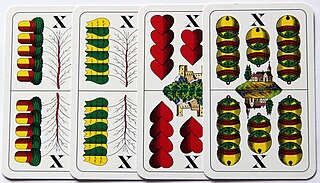 W
WMatzlfangen is a traditional point-trick, card game for 4 players that originated in the Austro-Bavarian region nearly 200 years ago. It is still played in a few places today. The game is named after the Ten or Matzl, which plays a key role.
 W
WMauscheln, also Maus or Vierblatt, is a gambling card game that resembles Tippen, which is commonly played in Germany and the countries of the old Austro-Hungarian Empire.
 W
WCheat is a card game where the players aim to get rid of all of their cards. It is a game of deception, with cards being played face-down and players being permitted to lie about the cards they have played. A challenge is usually made by players calling out the name of the game, and the loser of a challenge has to pick up every card played so far. Cheat is classed as a party game. As with many card games, cheat has an oral tradition and so people are taught the game under different names.
 W
WMulatschak or Fuchzenawa is an Austrian card game for two to five players that comes from the Salzburg area and is considered the quintessential game of the region. Although Mulatschak has been called the national card game of Salzburg, its rules were almost certainly unpublished before 2004. Mulatschak is a member of the Rams family in which the key feature is that players may choose to drop out of the game if they believe their hand is not strong enough to take a minimum number of tricks. There is a variant known as Murln or Murlen, which is played in Vienna and the Styria.
 W
WMulatschak or Fuchzenawa is an Austrian card game for two to five players that comes from the Salzburg area and is considered the quintessential game of the region. Although Mulatschak has been called the national card game of Salzburg, its rules were almost certainly unpublished before 2004. Mulatschak is a member of the Rams family in which the key feature is that players may choose to drop out of the game if they believe their hand is not strong enough to take a minimum number of tricks. There is a variant known as Murln or Murlen, which is played in Vienna and the Styria.
 W
WPerlaggen, formerly Perlagg-Spiel, is a traditional card game which is mainly played in the regions of South Tyrol in Italy, the Tyrolean Oberland and the Innsbruck areas of Austria. It is the only card game to have been recognised by UNESCO as an item of Intangible Cultural Heritage.
 W
WPoint Tarock was a three-player tarot card game, played mainly in Austria, which used the 54-card Industrie und Glück deck. Furr describes it as being "identical to Tapp but for the addition of a special announcement, allowing a Declarer to capitalize on a very good hand... spicing up the game considerably." Point Tarock is sometimes confused with its close cousin, Illustrated Tarock.
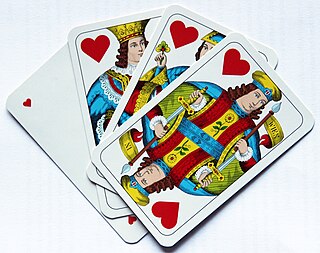 W
WPréférence is a Central and Eastern European 10-card plain-trick game with bidding, played by three players with a 32-card Piquet deck, and probably originating in early 19th century Austria also played by Russia highest echelon. A variant known as Preferans is very popular in Russia, and other variants are played from Lithuania to Greece.
 W
WRamsen or Ramsch is a traditional Bavarian plain-trick, card game for three to five players that is played with a 32-card German-suited pack and is suitable both for adults and for children. It is one of the Rams group of card games that are distinguished by allowing players to drop out if they think they will fail to win the required number of tricks. An unusual feature of Ramsen is the presence of four permanent trump cards that rank just below the Trump Sow. It should not be confused with the contract of Ramsch in games like Skat or Schafkopf, nor with the related game of Rams which is also called Ramsen in Austria, but is played with a Piquet pack, does not have permanent trumps and has a different card ranking.
 W
WSchnalzen is an Austrian card game for 4 players and a member of the Rams group of games in which the key feature is that players may choose to drop out of the game if they believe their hand is not strong enough to take a minimum number of tricks. It is, broadly speaking, Ramsen with the Weli as the second-highest trump. Players are dealt 5 cards and may not exchange. The Weli is the second-highest trump and game is 20 points.
 W
WSchnapsen or Schnapser is a trick-taking card game of the Bézique (Ace-Ten) family that is very popular in Bavaria and the territories of the former Austro-Hungarian Empire. Schnapsen is both of the point-trick and trick-and-draw subtypes.
 W
WCheat is a card game where the players aim to get rid of all of their cards. It is a game of deception, with cards being played face-down and players being permitted to lie about the cards they have played. A challenge is usually made by players calling out the name of the game, and the loser of a challenge has to pick up every card played so far. Cheat is classed as a party game. As with many card games, cheat has an oral tradition and so people are taught the game under different names.
 W
WSkwitz was a 19th-century Austrian card game of the fishing type for 2 to 8 players that was said to be of English origin. It may be a descendant of Cassino which it resembles.
 W
WBieten, Laubbieten, Lab bietn or Labbieten or Bavarian Poker is a card game that is popular in the Austrian Tyrol and the Bavarian Prealps. It used to be a game frequently played by timber rafters and muleteers. It can be seen as a precursor to the traditional Tyrolean game of Perlaggen. The unusual feature of Bieten is the nature of the competition. The players have the option, even if they have a poor hand, of persuading their opponent(s) to cave in through skilful bidding (Bieten) and bluffing.
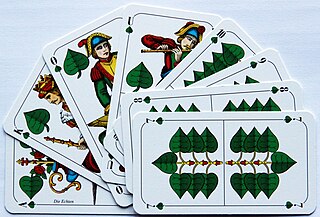 W
WSticheln is an easy-to-learn, trick-taking, card game for 4 players that originated from Austria. It is an old game, being recorded as early as 1756 and its rules being first described in 1830.
 W
WStrohmandeln, also called Strohmandel, Strohmanntarock, Strohmanntarok, Zweiertarock, Strawman Tarock or Straw Man Tarock, is an old, two-hand card game from the Austrian branch of the Tarock family. It takes its name from the three-packet talon of four cards, the Strohmänner ("strawmen"), each player has at the start of the game. While the original game has been described as jejune, it was eventually superseded by an attractive successor which is both challenging and very exciting.
 W
WTapp Tarock, also called Viennese Tappen, Tappen or Tapper, is a three-player tarot card game which traditionally uses the 54-card Industrie und Glück deck. Before the Anschluss (1938), it was the preferred card game of Viennese coffee houses, for example, the Literatencafés and Café Central. Even today Tapp Tarock is played sporadically. The exact date when it appeared is not possible to identify; some sources suggest it may have been developed in Austria in the early 19th century, but its mention in caricature operas in 1800 and 1806 suggest it was well known even by then and must have arisen in the late 18th century. The oldest description of the actual rules is dated to 1821. Tapp Tarock is considered a good entry level game before players attempt more complex Tarock forms like Cego, Illustrated Tarock or Königrufen.
 W
WTaroc l'Hombre or Tarok-l'Hombre is an extinct card game of the European Tarot card game family for three players that was played with a full pack of 78 tarot cards, known as tarocs or taroks. It emerged in Italy around 1770 as Tarocc 'Ombre but later spread to Austria and Germany. It was a crucial development, with the important idea of bidding imported from l'Hombre, hence the name.
 W
WTippen, also known as Dreiblatt, Drei Karten, Dreekort, Kleinpréférence or Labet, is an historical German 3-card, plain-trick game which was popular as a gambling game for three or more players. In Denmark essentially the same game was known as Trekort. It appears to be related to the English game of 3-Card Loo. It was banned as a gambling game in some places.
 W
WViennese Rummy is a matching card game of the Rummy family for 2-6 people played in continental Europe.
 W
WWatten, regionally also called Watteln or Wattlung, is a card game that is mainly played in Bavaria, Austria, Switzerland and South Tyrol. There are several main variants: Bavarian, Bohemian, South Tyrolean (Stichwatten), (Austrian) Tyrolean, Kritisch and Blind Watten. It is usually a 4-player game, which is "by far the most interesting", but it may also be played by 2 or 3 players. Parlett says that "though hard to describe, Watten is fun to play and easy to learn."
 W
WBieten, Laubbieten, Lab bietn or Labbieten or Bavarian Poker is a card game that is popular in the Austrian Tyrol and the Bavarian Prealps. It used to be a game frequently played by timber rafters and muleteers. It can be seen as a precursor to the traditional Tyrolean game of Perlaggen. The unusual feature of Bieten is the nature of the competition. The players have the option, even if they have a poor hand, of persuading their opponent(s) to cave in through skilful bidding (Bieten) and bluffing.
 W
WZehnerlegen, Zehneranlegen or Zehner-Auflegen is a card game of the Domino family that is usually played with German-suited cards of the Bavarian pattern, the aim of which is to be first to shed all one's cards. It is thus a shedding-type card game. The name means "laying tens" and refers to the Tens (Zehner) which are the first card in each suit to be played to the table. It is played in Bavaria and in the Austrian state of Burgenland.
 W
WZwanzigerrufen or Zwanz'gerrufen is the leading trick-taking card game of the Tarock family in many regions of eastern Austria. Its rules are simpler than the game of Königrufen which is more widely played in the whole of Austria. As is common in Tarock games, the cards have various point values – the primary goal in an individual game is to win the majority of points.
 W
WCheat is a card game where the players aim to get rid of all of their cards. It is a game of deception, with cards being played face-down and players being permitted to lie about the cards they have played. A challenge is usually made by players calling out the name of the game, and the loser of a challenge has to pick up every card played so far. Cheat is classed as a party game. As with many card games, cheat has an oral tradition and so people are taught the game under different names.
 W
WZwicken is an old Austrian and German card game for 4 to 6 players, which is usually played for small stakes and makes a good party game. It is one of the Rams group of card games characterised by allowing players to drop out of the current game if they think they will be unable to win any tricks or a minimum number of tricks.